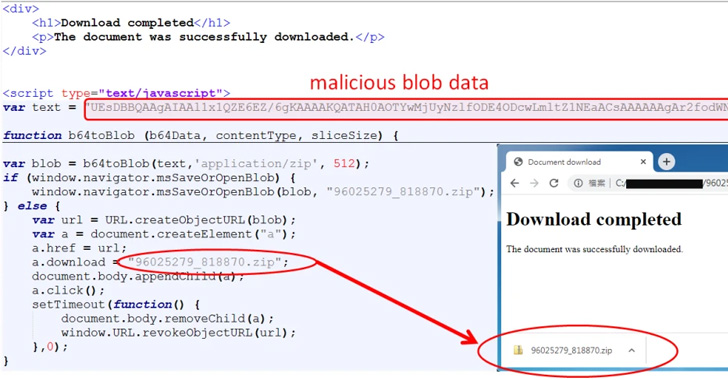
Hackers Exploiting Follina Bug to Deploy Rozena Backdoor
7.8 High
CVSS3
Attack Vector
LOCAL
Attack Complexity
LOW
Privileges Required
NONE
User Interaction
REQUIRED
Scope
UNCHANGED
Confidentiality Impact
HIGH
Integrity Impact
HIGH
Availability Impact
HIGH
CVSS:3.1/AV:L/AC:L/PR:N/UI:R/S:U/C:H/I:H/A:H
9.3 High
CVSS2
Access Vector
NETWORK
Access Complexity
MEDIUM
Authentication
NONE
Confidentiality Impact
COMPLETE
Integrity Impact
COMPLETE
Availability Impact
COMPLETE
AV:N/AC:M/Au:N/C:C/I:C/A:C
A newly observed phishing campaign is leveraging the recently disclosed Follina security vulnerability to distribute a previously undocumented backdoor on Windows systems.
“Rozena is a backdoor malware that is capable of injecting a remote shell connection back to the attacker’s machine,” Fortinet FortiGuard Labs researcher Cara Lin said in a report this week.
Tracked as CVE-2022-30190, the now-patched Microsoft Windows Support Diagnostic Tool (MSDT) remote code execution vulnerability has come under heavy exploitation in recent weeks ever since it came to light in late May 2022.
The starting point for the latest attack chain observed by Fortinet is a weaponized Office document that, when opened, connects to a Discord CDN URL to retrieve an HTML file (“index.htm”) that, in turn, invokes the diagnostic utility using a PowerShell command to download next-stage payloads from the same CDN attachment space.
This includes the Rozena implant (“Word.exe”) and a batch file (“cd.bat”) that’s designed to terminate MSDT processes, establish the backdoor’s persistence by means of Windows Registry modification, and download a harmless Word document as a decoy.
The malware’s core function is to inject shellcode that launches a reverse shell to the attacker’s host (“microsofto.duckdns[.]org”), ultimately allowing the attacker to take control of the system required to monitor and capture information, while also maintaining a backdoor to the compromised system.
The exploitation of the Follina flaw to distribute malware through malicious Word documents comes as social engineering attacks are relying on Microsoft Excel, Windows shortcut (LNK), and ISO image files as droppers to deploy malware such as Emotet, QBot, IcedID, and Bumblebee to a victim’s device.
The droppers are said to be distributed through emails that contain directly the dropper or a password-protected ZIP as an attachment, an HTML file that extracts the dropper when opened, or a link to download the dropper in the body of the email.
While attacks spotted in early April prominently featured Excel files with XLM macros, Microsoft’s decision to block macros by default around the same time is said to have forced the threat actors to pivot to alternative methods like HTML smuggling as well as .LNK and .ISO files.
Last month, Cyble disclosed details of a malware tool called Quantum that’s being sold on underground forums so as to equip cybercriminal actors with capabilities to build malicious .LNK and .ISO files.
It’s worth noting that macros have been a tried-and-tested attack vector for adversaries looking to drop ransomware and other malware on Windows systems, whether it be through phishing emails or other means.
Microsoft has since temporarily paused its plans to disable Office macros in files downloaded from the internet, with the company telling The Hacker News that it’s taking the time to make “additional changes to enhance usability.”
Found this article interesting? Follow THN on Facebook, Twitter and LinkedIn to read more exclusive content we post.
7.8 High
CVSS3
Attack Vector
LOCAL
Attack Complexity
LOW
Privileges Required
NONE
User Interaction
REQUIRED
Scope
UNCHANGED
Confidentiality Impact
HIGH
Integrity Impact
HIGH
Availability Impact
HIGH
CVSS:3.1/AV:L/AC:L/PR:N/UI:R/S:U/C:H/I:H/A:H
9.3 High
CVSS2
Access Vector
NETWORK
Access Complexity
MEDIUM
Authentication
NONE
Confidentiality Impact
COMPLETE
Integrity Impact
COMPLETE
Availability Impact
COMPLETE
AV:N/AC:M/Au:N/C:C/I:C/A:C


